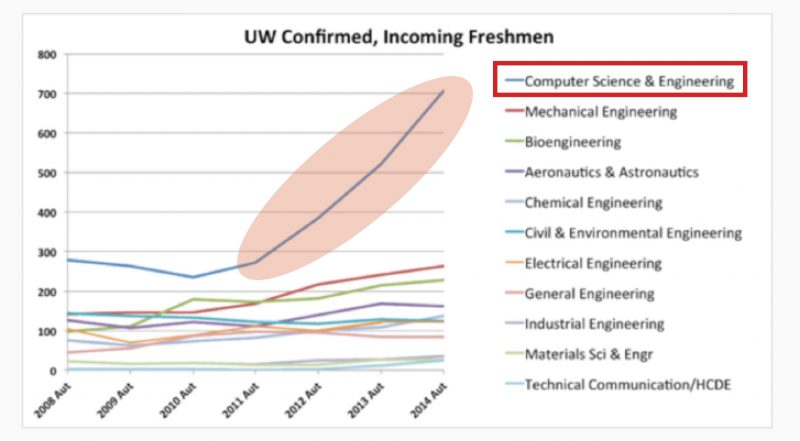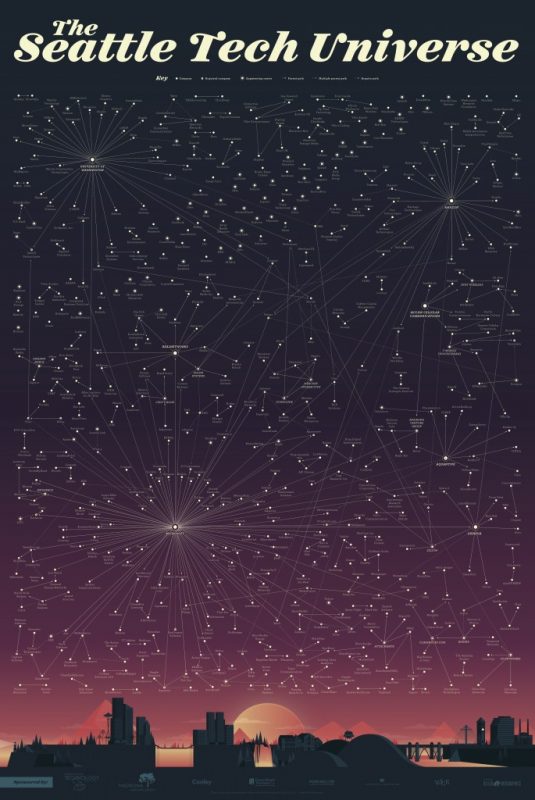According the Washington State Employment Security Department (ESD), Washington added 93,700 new jobs from January 2015 to January 2016. In the same period during the previous year the state added 100,500. In each year, nearly 70% of all such job growth took place in the Seattle-Bellevue-Everett MSA.
There is no question that job growth in the Seattle region remains staggering good. We are lucky. Yes, pinch yourself that you decided to move here/were born here/got a job here. It is March and the sun has finally arrived – pinch yourself again.
Yet, how did we get here? Will it last?
Myriad theories support economic vibrancy, how to create it and what sustains it. Good education systems. Great employers. Access to the arts. Creative food trucks. In Seattle, however, a confluence of factors brought the region to the point of epic job growth and a flywheel effect is bound to sustain it.
It Took 10 Years to Become an Overnight Success
As of late, when I travel the nation I get surprisingly similar responses when indicating Seattle as my home. “Wow, I hear that place is crazy right now!” “Do you work for Amazon?” “I heard Seattle is totally cool.” I didn’t get these comments 5 years ago. In the past, I certainly never had someone from New York remotely curious about life and times in Seattle – aka Southeast Alaska. Just this morning another Seattle-centric editorial hit the NYT.
The reality is that Seattle’s traverse along the path of innovative growth and national (global?) importance began many decades ago. Seattle’s seemingly meteoric rise found root in what are now very mature technology companies.
If I told you Microsoft will celebrate its 41st birthday next week you may be mildly surprised. Yet, did you realize that Amazon’s sales date back 22 years? The youthful, innovative Zillow is a ripe-old 10 years old – Redfin is even older. In modern technology circles, a company’s cache is almost defined by how undiscovered it is – yet ecosystems of innovation require density.
In an article published in late 2013, Dean Stangler explored the impact of such technological density. He wrote:
“Regional entrepreneurship ecosystems, aka startup communities, are being studied and touted as the next new thing in economic development for cities and metropolitan areas across the country… [a]nd for good reason. According to a report by Ian Hathaway of Engine that looked closely at the dynamism of the high-tech and information technology sectors in the United States… these are the firms that create jobs at the fastest pace and are important drivers of economic growth.”
Interestingly, of all regions studied over a 20 year period, the Seattle-Bellevue-Everett MSA topped the list for change in high-tech startup density.

SOURCE: Path-Dependent Startup Hubs, Dane Stangler published in September 2013
That Was Then, This is Now
Stenglers’ article was published several years ago; the data set from the report ended in 2010. How are we looking now? Quite good!
The following Seattle Tech Universe map is a stunning graph assembled by Madrona Venture Capital and the Washington Technology Industry Association. Beyond the sheer massiveness of innovation and sectors covered by the constituent companies – the interconnectivity of each is the basis of the ecosystem driving our region forward.
I highly encourage you to click on the image below and explore it further:
CLICK ON IMAGE TO ENLARGE
SOURCE: Madrona Venture Group (Original Post)
We’re Just Getting Started
In Enrico Moretti’s top-selling book, The New Geography of Jobs, heralded by Forbes as “easily the most important read of 2012,” the author drew the connecting between higher education and jobs. Yet, unlike the simple math of “more education = more jobs,” Moretti established deeper connections.
First, the multiplier effect. Where innovative jobs grow, all jobs grow. If a programmer receives a higher wage at Amazon, they can then pay more for a haircut, a cup of coffee and dog grooming services – and afford more frequency of all such services. All ships rise.
Second, Moretti found a deep correlation to a particular department in a university and beyond that, a particular professor that can change the game for the university and the region. Oren Etzioni was one such professor. Prof. Etzioni was the first student to major in Computer Science at Harvard University and went on to become one of the most entrepreneurial professors in the nation during his 22 years at the University of Washington.
Although Prof. Etzioni was recently recruited to lead Paul Allen’s Artificial Intelligence Institute, his impact on University of Washington, and the region, cannot be overstated. If the direction of UW’s computer science enrollment is any bellwether, computer science students, graduates, workers and then entrepreneurs will be on the rise in our region for decades to come.

The Flywheel
The key to Seattle’s innovation economy is momentum and interconnectivity. Efforts of get the flywheel spinning date back to seeds planned decades ago. Yet, flywheels require continuous input. The confluence of established, mature innovative companies, new market entrants and a continuous supply of talent (arriving as existing workers and students alike) ensure future dynamism in our economy.
Regional growth experienced in the front-half of this decade is merely the tip of the iceberg. Expect fundamentals sewn within our innovative ecosystem to produce similar flywheel-esque outputs for decades to come.
Understanding both current and future market dynamics is critically important in positioning both your assets and your investment thesis for optimum returns. Our apartment investment sales team, comprised of four highly qualified professionals, and a back-office team of an additional four dedicated staff, specializes in assisting apartment owners in maximizing returns. We focus on representing buyers and sellers of apartment assets from 5 units to 500 units. Please give me a call to discuss how we can turn our expertise into your profit. – Dylan


